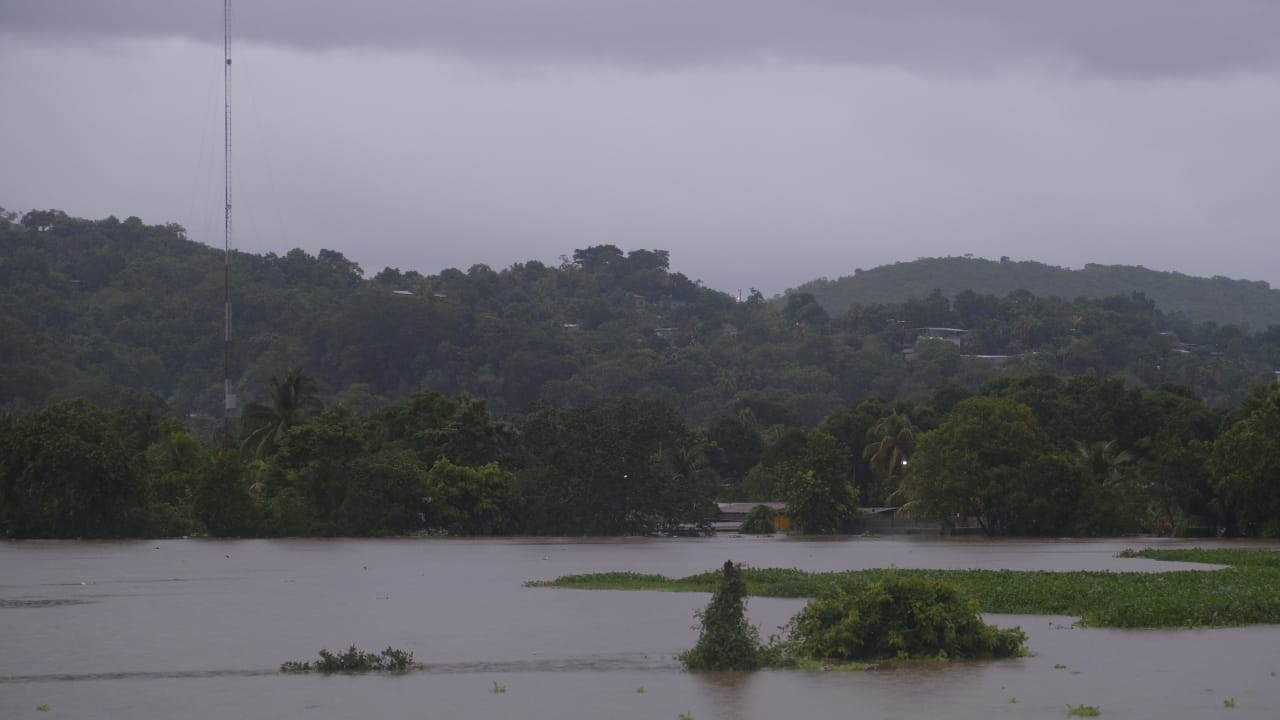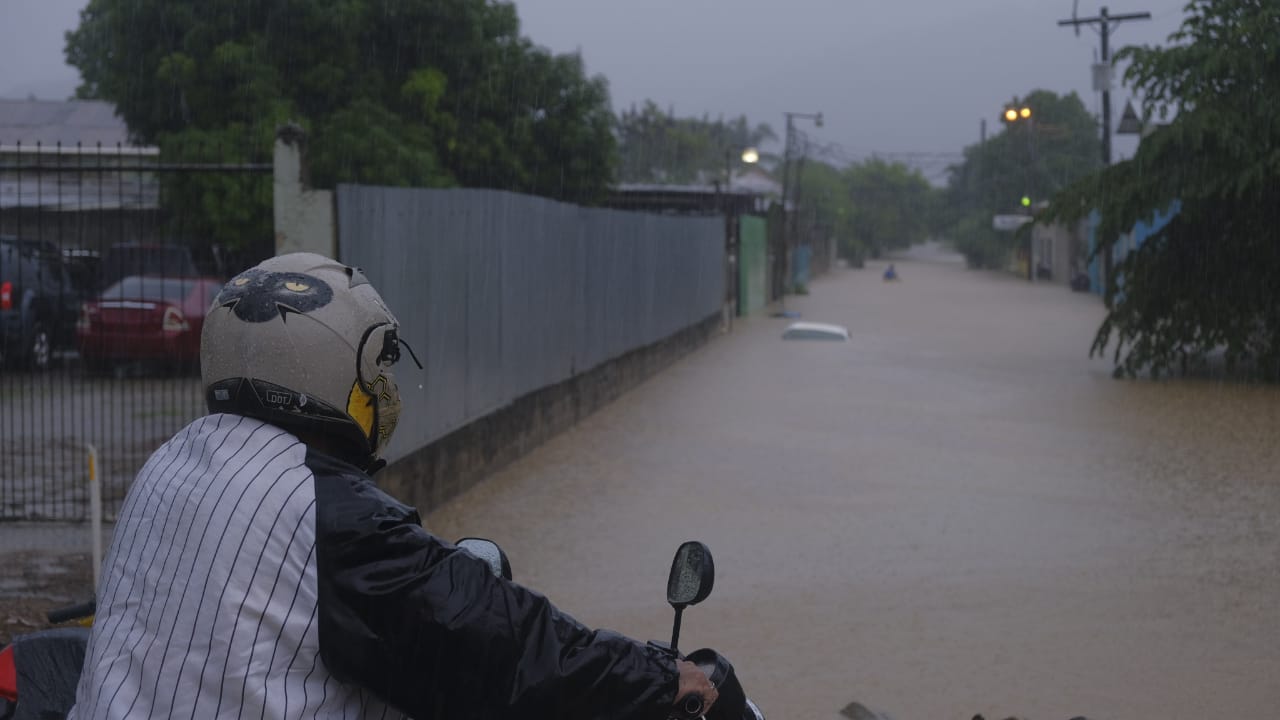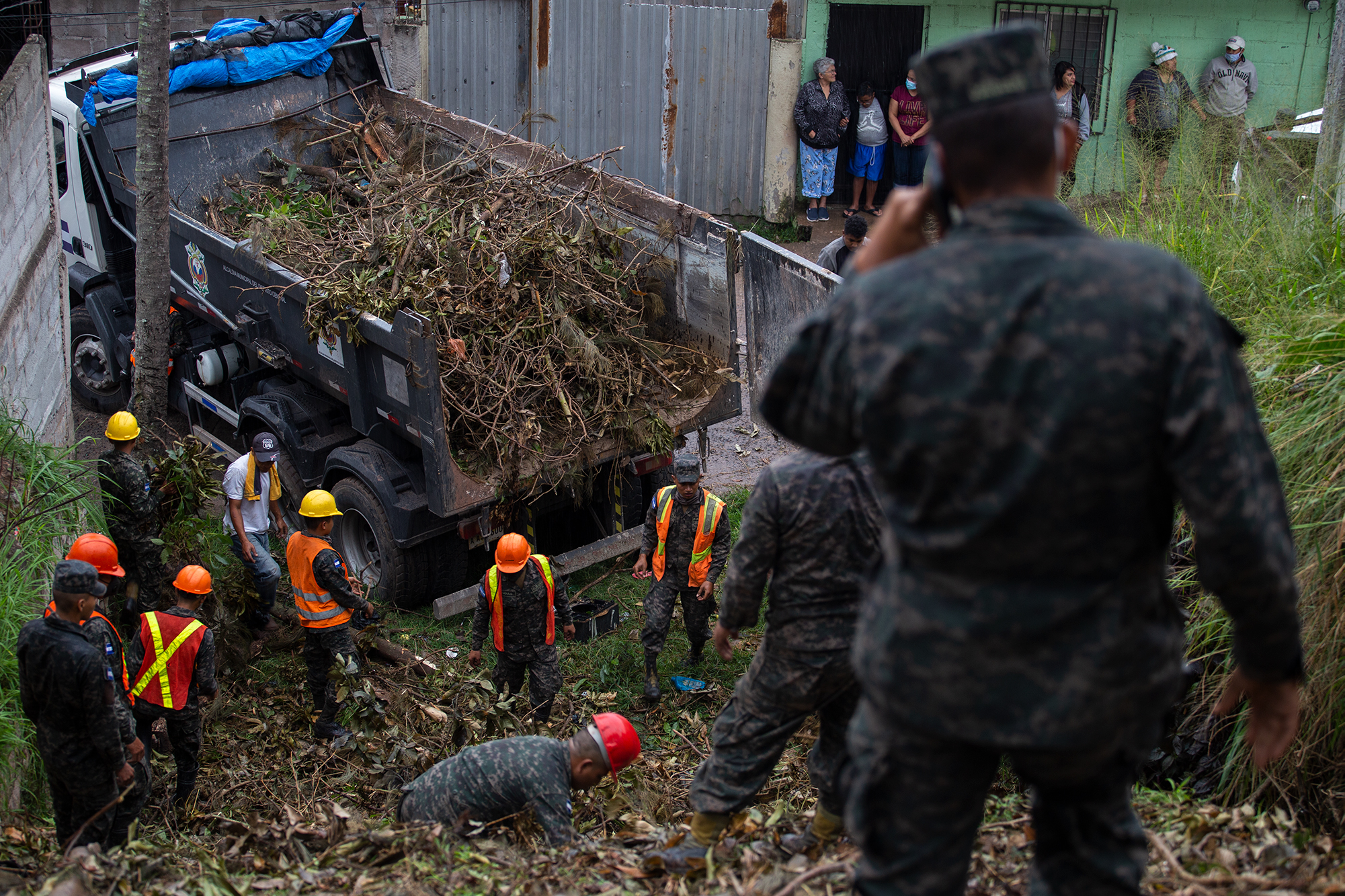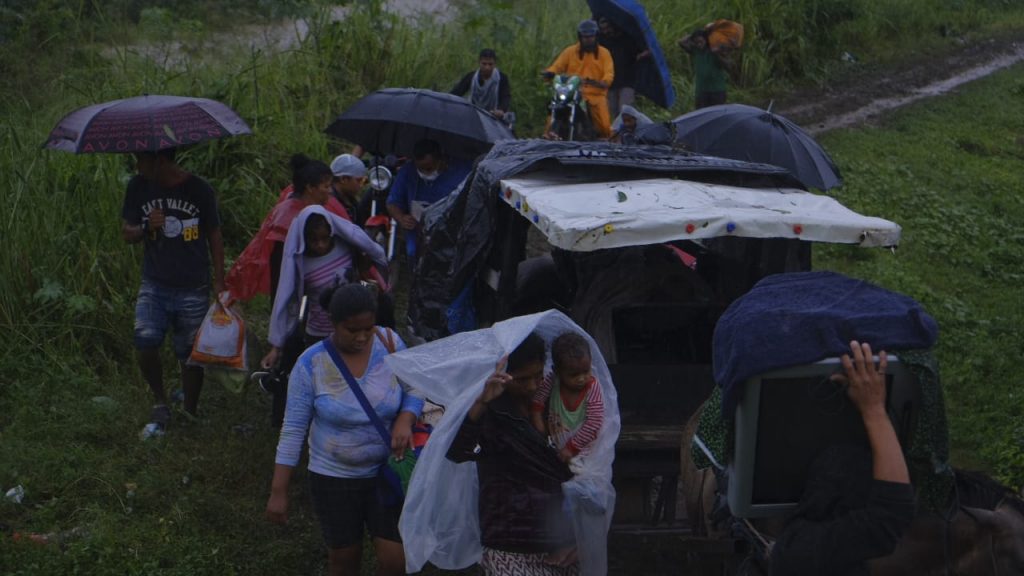Article by Leonardo Aguilar with reporting from Allan Bu, Ana Irías, and Deiby Yánes
Photography by Deiby Yánes and Martín Cálix
Translated by Emma Beavins
Officially, Honduras has reported 500 damaged houses, 26 cut off highways, tree loss, and dozens of communities waterlogged by overflowing rivers. The destruction, however, is clearly much greater.
This week, the Honduran government has moblized all its institutional and media-based weight in order to put on the long-awaited Morzanian Holiday. The event was scheduled to commence on Wednesday; however, it received severe criticism from the Medical College of Honduras (CMH) because vacationing on the beaches and tourist sites without restrictions was authorized in the middle of a pandemic. However, the arrival of Eta disrupted the plans of the government — which decided not to warn the public about the danger in a timely manner. They waited until the day the storm began, Wednesday Nov. 4, to declare a total red alert.
Last Monday, prior to the floods, the countries of Central America were already preparing to face hurricane Eta, but Honduras insisted on the holiday. “We are declaring that the Morazanian week will not be canceled, the holiday continues,” stated the secretary of tourism, Nicole Marrder. Hours later, she had to rectify the decision and watch how, little by little, the most vulnerable sectors of the country were flooded. Thousands of inhabitants had to leave their homes only with the clothes on their backs, their own supplies, and without help from the Honduran state.

On Tuesday of this week, the Permanent Commission of Contingencies (Copeco) indicated that hurricane Eta would enter Honduras just as a tropical storm – a statement which caught the attention of the United States’ National Center of Hurricanes (NHC in English). The NHC questioned the Honduran government for having discontinued its surveillance of hurricane Eta.
President Juan Orlando Hernandez, who had a strong personal interest in the Morazanian Holiday, finally declared a red alert after five days of intense rain and 8 deaths from the floods. Since Thursday, the onslaught of tropical storm Eta has left highways cut-off, houses flooded and bridges fallen. Hernandez’s appearance with the authorities of the National Police and other secretaries of state took place in the presence of the head of Joint Chiefs of Staff of the Armed Forces, Tito Livio Moreno.
“The problem is that the floods are going to continue. The country has an enormous quantity of water that has accumulated in the soil. We are having an unbelievable winter,” said president Juan Orlando Hernández this Thursday morning on channel HCH, a pro-government station, where he was able to justify the delayed measures.
This is the president who, before the hurricane, had appointed Max Gonzales — known as “Killa” for his past as a reggae singer — to the head of the Permanent Commission of Contingencies (Copeco). Killa was placed there in order to address the COVID-19 pandemic after his predecessors Gabriel Rubí and Carlos Cordero were accused of corruption in the handling of the pandemic. But Killa never imagined that he would face a devastating cyclone like Eta. When he first took office to confront COVID-19, he clumsily admitted to the media that he did not have any type of academic preparation to mitigate natural disasters, as he made clear in Tiempo.hn.



Copeco has only officially declared two deaths during this emergency, registered in the northern zone of Honduras. A girl identified as Norelys Gámez Bonilla (13 years old) died in the neighborhood El Carmen de San Pedro Sula and Esteven Gabarrete Isaula (15 years old) lost his life in Sulaco, Yoro.
The differences in how Honduras’ neighboring countries have acted are notable and contrast with the apathy of the government, which warned of the dangers on Wednesday. Nicaragua evacuated more than 3,000 people before the hurricane, which was a category 4 at the time it hit its Caribbean shores, as was reported last Monday on the site Nicaraguainvestiga. El Salvador also declared a red alert in the country well before Honduras, suspended various activities, and warned of the dangers of hurricane Eta even though they were not directly affected by the phenomenon, as noted by the site Elsalvador.com.
Contracorriente is visiting the most affected areas in the zone of the Valley of Sula, in northern Honduras, where the government waited days to declare the red alert and where the warnings arrived with the water.
People on the roofs in the neighborhood Planeta de la Lima, Cortes.
Lima and its surrounding neighborhoods have been the sectors most hit by the hurricane, now diminishing into tropical depression Eta. This Thursday, hundreds of people were ejected by water that suddenly barged into the center of Lima, in the neighborhoods of Planeta, La Jerusalén, and San Cristóbal, among other severely affected sectors.
A large number of people managed to escape with just the clothes they had on, to the boulevard that leads from San Pedro Sula to El Progreso, northern zone – but the problem didn’t end there. Hundreds of people are trapped on the roofs of their houses, desperately asking for help and facing the threat of the water.
The ineffectiveness of the authorities has led some citizens to solidarity; they are organizing rescue teams to respond to the anguished call that many people have made via videos circulating on social media.
Desperate calls of help from Chamelecón
The late response by the state and state authorities has generated a chaos that has put thousands of Honduran families in danger. A portion of these families are part of our Contracorriente team; Jimmy Girón y Abigail Molina are both located in Chamelecón, and have been asking for help for the last 24 hours.
Contracorriente has made calls to Copeco to send boats to our colleagues, without receiving any response.
Families out in the open because of floods in Potrerillos, Cortés
The inhabitants of the Príncipe de Paz neighborhood in Potrerillos, Cortés were left out in the open after the water covered nearly all of their homes. On Tuesday, around 2 p.m., the inhabitants of this neighborhood were surprised by a current that in less than 45 minutes had flooded the majority of houses. The owners were not able to take their belongings.
One of the affected is Alexis Padilla, who told us how surprised they were by the water. “We did not take anything because we were not given the chance, when the cars came it was already too hard to get in. Suddenly a rush of water came as if it were a wave,” said Padilla.
She maintained that they asked for help that never arrived. “The relief corps were called, but suddenly they had other emergencies.” It is also outrageous that after a day spent out in the open, those affected recounted that no person of authority was sent to them. “We did not see the authorities,” they said. Claudia García, who is the president of the community board, accepts that they have been asking people to pass through CA-5, which links the main cities of Honduras, San Pedro Sula and Tegucigalpa — northern and central zone, respectively. “We are hungry,” she said.
The swiftness with which the water overtook their houses did not allow them to save their belongings. “We do not have a bed in which to sleep, we are in the open. We only go out with what we are wearing,” he says.
Marta García, Claudia’s sister, called on the president of the republic, Juan Orlando Hernández, to attend to her emergency because the municipal authorities of their locality never helped them, she argues. When she saw her flooded house, her eyes filled with tears, and she could not finish the story.

Lima, Cortés registers severe flooding
The Honduran government, which was busy preparing for Morazanian week, did not prepare shelters. Thus, the flooding of the river Chamelecon, one of the largest rivers in Honduras, caused nearly 50 families from the Canaan and September 23 neighborhoods to relocate in shacks on the sides of boulevard on Wednesday. Soaked with rain, in the median of the highway that runs from San Pedro Sula to El Progreso, they watched as their houses lay below the water.
In addition, the rain that fell in the country with the arrival of Eta caused the Chamelecon river to reach its highest water levels, alarming everyone who lives around it.
One of the people who had to flee, was don Rolando Guzman Monje, who set himself up on the edge of the highway with his two grandchildren and his wife. “I do it for them not so much for the things. Imagine if the river would have come for us in the night. God forbid,” he told us.
For the past seven years, they have not had to abandon their house due to the threat of flooding. Now, they have to because of the amount of water getting in. He affirmed that he preferred to not go to a shelter and that he has always stayed on the highway when the waters of Chamelecon threaten his security.
At the time of writing, the families were without any government or municipality assistance. “If they come, it will be to ask for our vote” complained don Rolando.
Interrupted passage between El Progreso and Santa Rita, in the department of Yoro
The passage between El Progreso and Santa Rita, Yoro was disrupted by the overflowing of La Cuatro revine. A powerful flow of water still blocks the passage of small and medium vehicles. Some trucks and busses have dared to try to pass.
The National Police have established checkpoints to prevent vehicles from crossing.
There you can find don German Dominguez, a security guard who left his job at 6 a.m. on Wednesday, but eight hours later, was not able to cross. He said that for a short while the level of water had gone down, but he still did not want to risk crossing on his motorcycle. He said that the flooding of this area often happens without the authorities looking for a solution.
Today, the Pelo and Ulua rivers broke their banks, leaving the whole city cut off.
Specialists call for staying alert in the face of Eta
Eta hit Nicaraguan as a category 4 hurricane last Tuesday, Nov. 3, entering through the city of Bilwi, where it has left a lot of damage.
Even though Eta made landfall as a category 4 hurricane, it was later downgraded to a category 2, sustaining winds of 175 kilometers per hour. The National Center for Hurricanes in the United States set off alerts about the collateral effects of the phenomenon. It has extended throughout the majority of Honduran territory, where there have been reports of strong rains that have caused flooding and landslides in various parts of the country.
According to doctor and dean of the Faculty of Science of the National Autonomous University of Honduras, Nabil Kawas, as the hurricane arrives on land, it will lose force, but that does not guarantee that the rain will disappear. That is why it’s necessary to be on alert and be warned of the damage for the rest of the week, which will be the most difficult days for the country.
Likewise, she mentioned how vulnerable Honduran land is to these natural phenomenons, “Our territory has always been vulnerable due to our orography, because it is very broken up with mountains and valleys and this leaves us vulnerable. We don’t take care of our territories, our watersheds.”
Kawas also expressed that Eta will affect 90% of the country, intensifying much more in some areas than in others, “For example we saw that here in Tegucigalpa and in the central zone up until now, the rains have been very little, but we should not relax, we must be alert.”
Red alert for Eta
Carlos Madero, the government’s coordinating secretary, assured the public that they are ready to attend to the emergency. “We can tell the public that both the funds for the COVID-19 emergency and funds for the emergency due to hurricane Eta are available. We have already completed a plan for the shelters and the availability of food for the population, and our teams are prepared.”
Similarly, Max Gonzales, commissioner of Copeco, stated that they would continue to monitor all of the actions of the advancing natural phenomenon. He added that more than 15 government institutions of the republic, civil society and the international community have extended personnel, equipment and resources in order to respond rapidly to the needs of the Honduran population.
In Tegucigalpa, the rain has been mild. However, several disasters have been reported, including a landslide in the neighborhood of Reparto por arriba, where according to the residents, the issue stemmed from the fact that the street was built five years ago. The respective analysis of the sewage pipes was never completed and now they are leaking – a situation that has been gradually damaging the streets since rain began in the capital. This incident, though minor, demonstrates the vulnerability of the Honduran capital.
Mario Solorzano, a resident in this sector, explained his anger at the authorities’ abandonment of the capital. “This could have been avoided. Here there are two houses completely destroyed and in my house where the landslide took one of the walls, there are four affected families, and the authorities only told us that we could go to a shelter. But that’s not the solution. What use are those shelters if the problem could have been avoided much earlier?”
Authorities of Copeco informed us that they were considering converting COVID-19 triage centers into shelters in the capital.


Honduras – among the most vulnerable countries in the world
Nelson Garcia, Director of the Mennonite Social Action Commission, stated that historically, Honduras has been one of the most vulnerable countries in the world in environmental matters. “We are one of the most vulnerable even though we are not the ones who pollute the most, nor do we generate pollution, nor climatic deterioration in the world. But we are among the most affected.”
Garcia laments the vulnerability that the country is experiencing and the complicated situation of facing phenomena like Eta. “It’s a cultural vulnerability. We are not prepared for the level of risk management necessary in order to meet international recommendations and measures. In some places in the country, the rescue teams have already arrived and many families have refused to evacuate for fear of losing the little that they have – putting their daughters, sons, and rescuers in danger,” he said.
The Mennonite Social Action Commission has worked for many years in the humanitarian network to ensure that educational centers are able to adopt guidelines that prepare children for these environmental catastrophes. “Our prevention education is extremely poor. We want to stop putting out fires every year.”
On the other hand, she referred to the discharge schedule of El Cajon, the state electric dam, “By opening El Cajon, the water will increase. It will reach the rivers and obviously this will cause them to overflow more consistently. But they are still the mitigation measures that they use. If there were more dams in the country, surely we would have a place to store this water that is lost.”
Government, in the midst of the crisis, still thinks of the Morazanian Holiday
The government that Joan Orlando Hernandez presides over has not forgotten the holiday in order to “stimulate tourism.” Yesterday, the National Congress approved to yet again move the so-called Morazanian holiday that normally takes place on the 3rd, 12th and 21st of October. It was already canceled once by the COVID-19 pandemic. Due to the strong storms of Eta, it will now be in the hands of the Executive Branch through the Council of Ministers, chaired by President Hernandez, to determine a new date.






